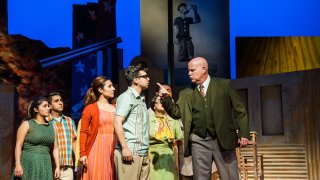
Cara Mia Theatre first produced “Crystal City 1969” in 2009.
In 1969, high school students in Crystal City, Texas reclaimed their cultural heritage, language, and political power by taking one step at a time – out of school. Cara Mía Theatre’s Crystal City 1969 chronicles the historic walkout that drew national headlines and changed a community. The play will run from Nov. 26 – December 18 at the Latino Cultural Center in Dallas.
David Lozano, Cara Mía Theatre’s Executive Artistic Director, and Raul Treviño wrote the bilingual play in advance of the 40th anniversary of the student walkout. The initial inspiration was Treviño’s family.
“Over the years, I sat at family reunions and heard so many stories about living in Crystal City and the migrant farmer experience, and it seemed so distant from the kind of experience I had. I just admired the courage and resilience that my family members shared through these stories. I was inspired by these stories, and I thought and had a hunch that others might be as well,” Treviño said.
Get DFW local news, weather forecasts and entertainment stories to your inbox. Sign up for NBC DFW newsletters.
In the 1960s, Latino students routinely faced discrimination in school. They were not allowed to speak Spanish, or participate in varsity sports and they were discouraged from attending college. On December 9, 1969, Crystal City High School students Severita Lara, Diana Serna and Mario Treviño led a historic walkout that inspired local Mexican Americans to run for political office.
When those candidates won a majority on the school board in 1970, institutional changes were implemented to Crystals City’s educational system including requiring all students K-12 to learn to read, write, and speak Spanish. The move inspired educators across the country to integrate bilingual education in their schools.
“This play is about the struggle of reclaiming our cultural heritage and what that means,” Treviño said.
Local
The latest news from around North Texas.
Lozano and Treviño worked on writing the show for a year, interviewing the student leaders of the protest, students who participated in the walkouts and several members of Treviño’s family who lived in Crystal City at the time. They were still working on the script up until its world premiere opening in 2009.
“We really wrote it in a fit of inspiration and alongside the support of a close-knit community of people,” Lozano said.
“We wanted to honor their contributions, their heroism, their leadership and so we were writing it for them as well. It made it an honor and a challenge,” Treviño said.
The real-life activists attended the opening.
“We opened 40 years to the day that they walked out of classes. We had them join us on the stage after the show and share their thoughts. It was electric. I think for the most part, they felt really honored by this effort,” Treviño said.
Cara Mía Theatre has revived this show several times, most recently in 2016.
“Even though we’ve revived this play multiple times, it still feels so fresh – fresh inspiration, fresh wounds and the passion remains fresh,” Lozano said.
Lozano was inspired to revive the show after the enthusiastic response to an outdoor reading of the play in Austin.
“Over 600 people showed up,” Lozano said. “Every time I work with this script and this story, I feel like I’m rediscovering some of the essential lessons that I’ve learned over the years. The play has served as a roadmap for my own awakening as someone who identifies as Chicano and works with the community.”
Each time Lozano directs the show, he appreciates working with young actors who are unaware of this chapter of history.
“It’s difficult for them to comprehend being spanked at all at school,” Lozano said. “Then to be spanked for speaking Spanish. And then potentially being slapped in the face for speaking Spanish. And then what are your options as a young person in Crystal City? Do you stay resilient and just keep going through school?”
“That what Crystal City was: a place where they were punished for speaking Spanish, where they were shamed for speaking Spanish,” Lozano said. “So, when we tell this story, it’s new to them.”
The play shows the transformative power of the ballot box.
“What’s very clear is the people of Crystal City have an awakening in which they begin to match the discrimination and the oppression of Crystal City with the political structures and the political dynamics, and they begin to realize they have been bullied from participating fairly in the electoral process. There is a step-by-step process in which they awaken to the reality of their political power, and they embrace it, they recognize it, and they act on it,” Lozano said.
In January 2023, the show will run for one week at the historic Guadalupe Cultural Arts Center in San Antonio.
“San Antonio was really the hotbed of the political activity of this era. In fact, the Chicano leaders assisted the young people in knowing their rights and defending their legal rights during the walkout in Crystal City,” Lozano said.
This show is for the next generation to realize their power to do good.
“My hope and my mission was that more people learn about this particular story, and that this story become a part of the fabric of the civil rights history of our state, of our nation,” Treviño said. “I remember hearing young people in talkback sessions after the show saying, ‘I thought I had to wait until I became an adult to make a difference in my community, but I’ve been inspired to know that I can do this now. That I can make a change in my community today. I don’t need to wait.’”
Learn more: Cara Mía Theatre